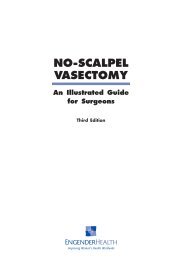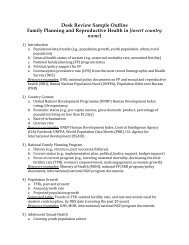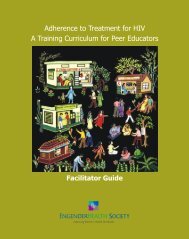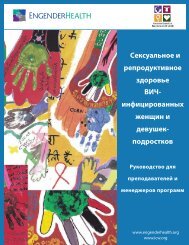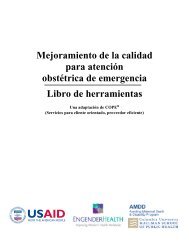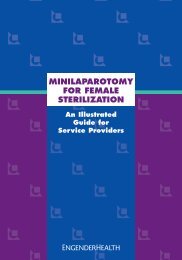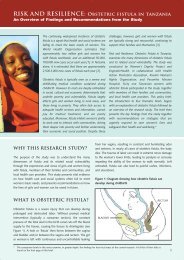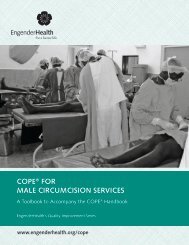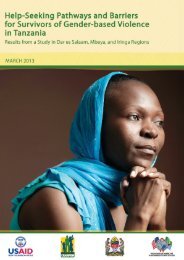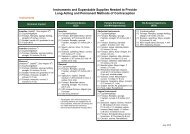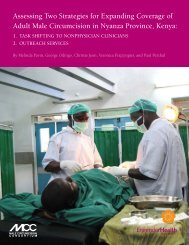Risk and Resilience: Obstetric Fistula in Tanzania - EngenderHealth
Risk and Resilience: Obstetric Fistula in Tanzania - EngenderHealth
Risk and Resilience: Obstetric Fistula in Tanzania - EngenderHealth
Create successful ePaper yourself
Turn your PDF publications into a flip-book with our unique Google optimized e-Paper software.
Table 1: Overall Purpose of <strong>and</strong> Issues Explored <strong>in</strong> Each Type of Tool<br />
Tool<br />
In-depth <strong>in</strong>terview on pregnancy<br />
labor <strong>and</strong> delivery (girls <strong>and</strong> women)<br />
In-depth <strong>in</strong>terview on experience with<br />
fistula (girls <strong>and</strong> women)<br />
In-depth <strong>in</strong>terview with family<br />
members on labor, delivery, impacts,<br />
<strong>and</strong> care-seek<strong>in</strong>g behavior<br />
Group discussions with providers <strong>and</strong><br />
community members<br />
Problem trees with women with<br />
fistula, family members, community<br />
members, <strong>and</strong> providers<br />
Freelist<strong>in</strong>g <strong>and</strong> rank<strong>in</strong>g with<br />
community members<br />
Overall purpose <strong>and</strong> issues explored<br />
To underst<strong>and</strong> factors related to women’s pregnancy, labor,<br />
delivery, <strong>and</strong> post-delivery experiences with the pregnancy<br />
that caused the fistula<br />
To underst<strong>and</strong> women’s experiences of liv<strong>in</strong>g with fistula,<br />
<strong>in</strong>clud<strong>in</strong>g impact <strong>and</strong> cop<strong>in</strong>g mechanisms<br />
To underst<strong>and</strong> family members’ perspectives on experiences<br />
<strong>and</strong> care-seek<strong>in</strong>g behavior related to the pregnancy that<br />
resulted <strong>in</strong> the fistula, the impact of fistula on the family,<br />
<strong>and</strong> cop<strong>in</strong>g strategies used by the family<br />
To underst<strong>and</strong> perspectives on socioeconomic, cultural, <strong>and</strong><br />
familial factors contribut<strong>in</strong>g to fistula<br />
To underst<strong>and</strong> root causes <strong>and</strong> beliefs about fistula <strong>and</strong><br />
cop<strong>in</strong>g strategies used to mitigate its impact.<br />
To underst<strong>and</strong> the three most important contribut<strong>in</strong>g factors<br />
to maternal health complications dur<strong>in</strong>g labor <strong>and</strong> delivery<br />
Problem Trees on <strong>Obstetric</strong> <strong>Fistula</strong><br />
A problem tree is a participatory, learn<strong>in</strong>g <strong>and</strong><br />
action (PLA) visual tool that allows participants to<br />
probe for the causes <strong>and</strong> consequences of a<br />
particular issue. Participants draw a “tree” <strong>and</strong><br />
<strong>in</strong>dicate the issue on the trunk of the tree. The roots<br />
of the tree are then the causes of the problem <strong>and</strong><br />
the branches are the consequences of the problem.<br />
Problem trees were carried out with women with<br />
fistula, family members, community members, <strong>and</strong><br />
providers to underst<strong>and</strong> beliefs about the causes<br />
<strong>and</strong> consequences of fistula. Respondents were<br />
asked the local names for fistula <strong>and</strong> how these<br />
were <strong>in</strong>terpreted locally <strong>and</strong> personally. This<br />
exercise also explored the cop<strong>in</strong>g strategies used to<br />
mitigate its impact.<br />
Freelist<strong>in</strong>g <strong>and</strong> Rank<strong>in</strong>g Exercises on<br />
Maternal Health Complications<br />
Freelist<strong>in</strong>g <strong>and</strong> rank<strong>in</strong>g is a PLA tool where<br />
participants bra<strong>in</strong>storm <strong>and</strong> list responses to a<br />
particular question. Once this has been completed,<br />
they then rank their responses <strong>in</strong> order of priority.<br />
In this study, community members identified the<br />
factors that contribute to maternal health<br />
complications dur<strong>in</strong>g labor <strong>and</strong> delivery <strong>and</strong> then<br />
ranked them <strong>in</strong> order of importance. Additionally,<br />
they were asked their op<strong>in</strong>ions about the different<br />
maternal health <strong>in</strong>formation <strong>and</strong> service needs of<br />
women of reproductive age <strong>in</strong> their community<br />
<strong>and</strong> their op<strong>in</strong>ion of general health care services <strong>in</strong><br />
their community.<br />
Group Discussions with Providers <strong>and</strong><br />
Community Members on Factors That<br />
Contribute to <strong>Fistula</strong><br />
Group discussions were carried out with providers<br />
<strong>and</strong> community members to underst<strong>and</strong> their<br />
perspectives on the socioeconomic, cultural, <strong>and</strong><br />
familial factors contribut<strong>in</strong>g to fistula. In addition,<br />
they were asked their recommendations about<br />
how fistula could be prevented.<br />
6



